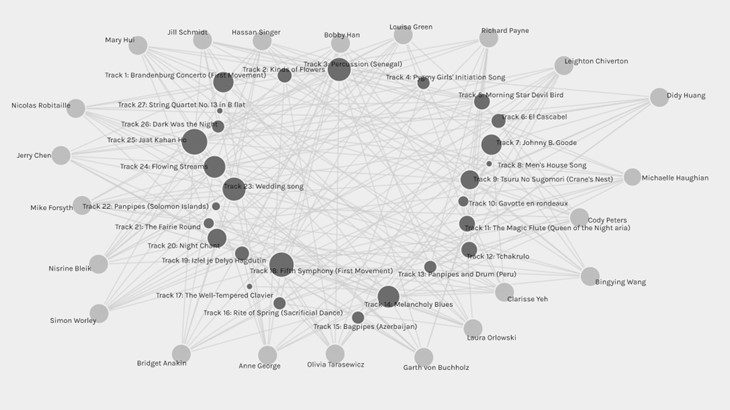
So I tried to organize the grey nodes (participants) on the outside perimeter and dark nodes (songs) on the inside and in numerical order. It was quite visually satisfying to drag and drop nodes, watching them and their edges snap and wiggle into place. Without selecting any “facets”, I had all the data as one massive tangled web, all participants connected to each song they chose. As is, it was information overload. Too much to make sense of the data.

Enter Facet #1. Immediately, a bunch of nodes and edges disappeared and 6 presumably random songs were isolated that generated a total of 55 edges. I only chose 1 of the 6 songs in this set. I tried to find similarities in the songs here but the closest I came to identifying any factor was possibly indigenous-related music of different continents and this didn’t apply to all of the songs. The most popular song in this subset was Track 23: Wedding Song (of which I did not choose, for reasons unknown through the visualization).

Enter Facet #2. Again, I chose only 1 of the 4 in this subset of Golden Record Songs and it happened to be the least popular track here. The most popular song here appears to be Track 24: Flowing Streams. I remember I didn’t choose this song despite its popularity in Chinese movies because it elicited a strong feeling of sadness and I do not generally like music that makes me feel down. That would also seem to contradict why I didn’t choose Track 7: Johnny B. Goode. I didn’t choose this one because I decided to stick to a theme of instrumental music that transcends language, for the purposes of reaching an alien species that most likely wouldn’t speak any of our languages.

Facet #3: I finally am more connected to this subset of songs! 5/6, not bad…. that’s 83%! I notice Cody Peters beat me with 6/6, 100%!! He must have excellent taste in music! ???? The most popular song here is Track 18: Beethoven’s Fifth Symphony (First Movement) and not surprisingly as it’s is so iconic and beautifully written. Also, it happens to be one of my favourite jokes I tell students “What is Beethoven’s favourite fruit?” “Ba-NA-NA-NAAAA!!!”

Facet #4: The clear favourite was Track 3: Percussion (Senegal). I am not surprised as I remember bopping to the rhythm and beats of this song. It was very up-beat, catchy and fun song. No sad, melancholic song here!

Facet #5: My name didn’t even register as I scored terribly here with 0%! ☹ The most popular track here is Track 25: Jaat Kahan Ho with 15 picks! I was going to choose this song because it was exotic but eventually I realized there were lyrics being sung, even though I didn’t understand it! So, sticking to my criteria of choosing only instrumental music, I was able to rule this one out.

Facet #6: The most popular song in this grouping is Track 1: Brandenburg Concerto (First Movement) which isn’t surprising because it is a peppy, upbeat and classic song! There are so many competing melodies by various instruments that it’s an audio delight for the ears!

Working with the Palladio App allowed for visualizations between participants and their music choices as well as how others faired with similar responses. Due to limited data input, factors influencing participants choices could not be isolated such as favourite music genre, musical selection criterion, emotional relevance, culture, race and gender. If we had data on these participant demographics and preferences, we could further analyze the data for possible correlation with musical selection.
Without more data, the groupings miss important factors, assumptions may happen and data can easily be misinterpreted. Simply having more people agree on the song’s “worthiness” elevates its status amongst the others. Much like the Internet, web pages are ranked according to how connected it is to other websites. While this may appear to legitimize good data, it also responsible for the rise in fake news simply because it is popular and often quoted. Thus controlling the flow of true information is a struggle which can spell political disaster for the government. It is no wonder there exists Bill C-18 in Canada, in an attempt to combat the inequality in news dissemination, for better or for worse.